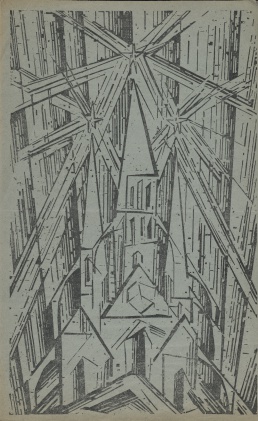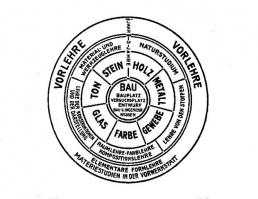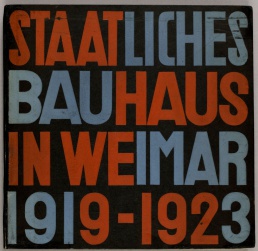Bauhaus

The Bauhaus was founded in 1919 in the city of Weimar by German architect Walter Gropius. Its core objective was a radical concept: to reimagine the material world to reflect the unity of all the arts. Gropius explained this vision for a union of crafts, art and technology in the Programm des Staatlichen Bauhauses Weimar (1919), which described a utopian craft guild combining architecture, sculpture, and painting into a single creative expression [Gesamtkunstwerk]. Gropius developed a curriculum that would turn out artisans and designers capable of creating useful and beautiful objects appropriate to this new system of living.
The Bauhaus combined elements of both fine arts and design education. The curriculum commenced with a preliminary course that immersed the students, who came from a diverse range of social and educational backgrounds, in the study of materials, colour theory, and formal relationships in preparation for more specialized studies. This preliminary course was often taught by visual artists, including Johannes Itten, László Moholy-Nagy, Josef Albers, Paul Klee, and Wassily Kandinsky, among others.
The workshops included metalworking, weaving, ceramics, carpentry, graphic printing, printing and advertising, photography, glass and wall painting, stone and wood sculpture, and theatre. Among the teachers were also Herbert Bayer, Marcel Breuer, Hinnerk Scheper, Joost Schmidt, Gunta Stölzl, and Walter Peterhans. (More about the workshops, classes, and teachers and students.)
In 1925, the Bauhaus moved from Weimar to Dessau. Gropius stepped down as director of the Bauhaus in April 1928, succeeded by the architect Hannes Meyer. Under pressure from an increasingly right-wing municipal government, Meyer resigned as director of the Bauhaus in 1930. He was replaced by architect Ludwig Mies van der Rohe. The political situation in Germany, combined with the perilous financial condition of the Bauhaus, caused Mies to relocate the school to Berlin in September 1932, where it operated on a reduced scale. The Bauhaus eventually dissolved itself under pressure from the Nazis in 1933.
During the years of World War II, many of the key figures of the Bauhaus emigrated to the United States, where their work and their teaching philosophies influenced generations of young architects and designers. Marcel Breuer and Joseph Albers taught at Yale, Walter Gropius went to Harvard, and Moholy-Nagy established the New Bauhaus in Chicago in 1937. [2] [3]
Books
| The following nine PDFs are linked from Bibliothèque Kandinsky which published them online on an unknown date. Follow this link to explore the respective entries on its website. This is an important milestone in the digitalization of essential but hard-to-get art publications for the public use and we would like to express our gratitude and appreciation. <3 ! The whole set of these high-quality digital facsimiles is about 1 GB large, if anyone feels like starting a torrent to relieve bandwidth of the library let us know and we'll include your link here. (17 Aug 2014). Update: you can now download the whole set in a single ZIP file from here. Thanks to Gabriel Benderski (29 Aug 2014). |
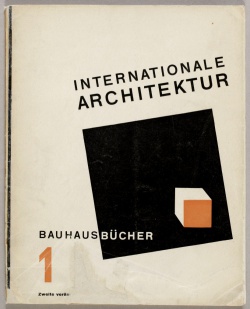 1. Walter Gropius (ed.), Internationale Architektur, 1925. 111 p., 23 cm. Download (111 MB). |
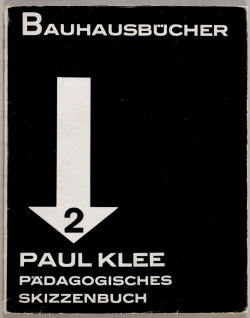 2. Paul Klee, Pädagogisches Skizzenbuch, 1925. 50 p., 23 cm. Download (33 MB). |
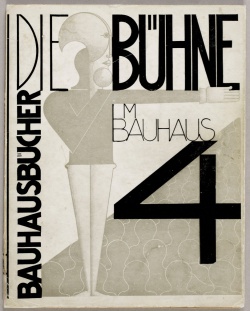 4. Die Bühne im Bauhaus, 1924. 84 p., 23 cm. Download (72 MB). |
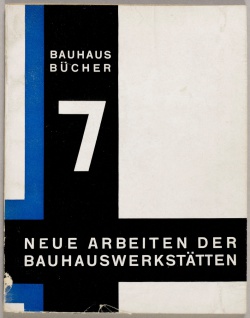 7. Neue Arbeiten der Bauhauswerkstätten, 1925. 115 p., 23 cm. Download (118 MB). |
 8. L. Moholy-Nagy, Malerei, Fotografie, Film, 2nd ed., 1927. 140 p., 23 cm. Download (131 MB). |
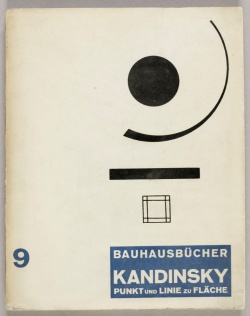 9. Kandinsky, Punkt und Linie zu Fläche: Beitrag zur Analyse der malerischen Elemente, 1926. 190 p., 23 cm. Download (134 MB). |
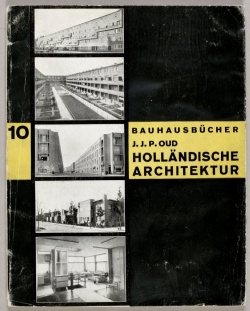 10. J.J.P. Oud, Holländische Architektur, 1929. 107 p., 23 cm. Download (89 MB). |
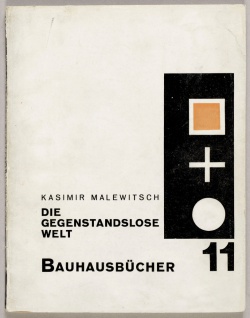 11. Kasimir Malewitsch, Die gegenstandslose Welt, 1927. 104 p., 24 cm. Download (84 MB). |
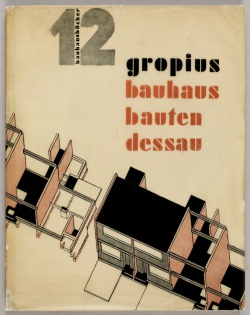 12. Walter Gropius, Bauhausbauten Dessau, 1930. 221 p., 23 cm. Download (222 MB). |
- 1. Walter Gropius, Internationale Architektur, Munich: Albert Langen, 1925, 111 pp.
- 2. Paul Klee, Pädagogisches Skizzenbuch, Munich: Albert Langen, 1925, 50 pp.
- Pedagogical Sketchbook, intro. & trans. Sibyl Moholy-Nagy, New York: Frederick A. Praeger, 1953, 65 pp; 1960. (in English)
- Παιδαγωγικό Σημειωματάριο, trans. Β. Λαγοπούλου, 1976. (in Greek)
- Pedagogikheskie eskizy, trans. N. Druzhkovoy, 2005. (in Russian)
- 3. Adolf Meyer (ed.), Ein Versuchshaus des Bauhauses in Weimar, Munich: Albert Langen, 1924, 78 pp.
- 4. Die Bühne am Bauhaus, Munich: Albert Langen, 1925, 84 pp.
- The Theater of the Bauhaus, trans. Arthur S. Wensinger, Middletown, Conn.: Wesleyan University Press, 1961. (in English)
- 5. Piet Mondrian, Neue Gestaltung, Neoplastizimus, Nieuwe Beelding, Munich: Albert Langen, 1925, 66 pp.
- 6. Theo van Doesburg, Grundbegriffe der neuen gestaltenden Kunst, Munich: Albert Langen, 1925.
- Principles of Neo-Plastic Art, London: Lund Humphries, 1969. (in English)
- 7. Walter Gropius (ed.), Neue Arbeiten der Bauhauswerkstäffen, Munich: Albert Langen, 1925, 115 pp.
- 8. L. Moholy-Nagy, Malerei, Fotografie, Film, Munich: Albert Langen, 1925, 115 pp; 2nd ed., 1927, 140 pp. Incl. "Dynamik der Gross-Stadt", pp 116-129.
- Painting Photography Film, trans. Janet Seligman, London: Lund Humphries, 1969. (in English)
- 9. Kandinsky, Punkt und Linie zu Fläche: Beitrag zur Analyse der malerischen Elemente, Munich: Albert Langen, 1926, 190 pp.
- Point and Line to Plane: Contribution to the Analysis of the Pictorial Elements, trans. Howard Dearstyne and Hilla Rebay, New York: Solomon R. Guggenheim Foundation, 1947, 200 pp. (in English)
- 10. J.J.P. Oud, Holländische Architektur, Munich: Albert Langen, 1929, 107 pp.
- 11. Kasimir Malewitsch, Die gegenstandslose Welt, Munich: Albert Langen, 1927, 104 pp.
- 12. Walter Gropius, Bauhausbauten Dessau, Munich: Albert Langen, 1930, 221 pp.
- 13. Albert Gleizes, Kubismus, Munich: Albert Langen, 1928, 101 pp.
- 14. László Moholy-Nagy, Von Material zur Architektur, Munich: Albert Langen, 1929, 241 pp; facsimile repr., Mainz and Berlin: Florian Kupferberg, 1968, 251 pp.
- The New Vision: From Material to Architecture, trans. Daphne M. Hoffman, New York: Breuer Warren and Putnam, 1930; exp.rev.ed. as The New Vision and Abstract of an Artist, New York: George Wittenborn, 1947. (in English)
Journal
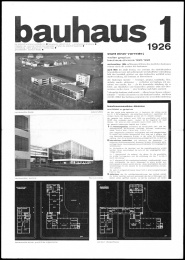 bauhaus 1 (1926). 5 pages, 42 cm. Download (23 MB). |
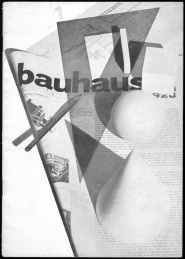 bauhaus: zeitschrift für bau und gestaltung 2:1 (Feb 1928). Download (17 MB). |
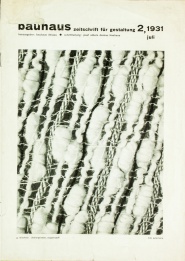 bauhaus: zeitschrift für gestaltung 2 (Jul 1931). Download (15 MB). |
The above PDFs are sourced from Beinecke Rare Book and Manuscript Library (1) and Baunet Reader (2-3).
- bauhaus, zeitschrift für gestaltung, eds. Walter Gropius and Laszlo Moholy-Nagy, 1926-28, Ernst Kallai, 1928-30, 14 issues, Dessau, 1926-31; repr., Nendeln: Klaus Reprint, 1977.
Other publications
(in German unless noted)
- Walter Gropius, Programm des Staatlichen Bauhauses Weimar, Weimar, April 1919, 4 pp.
- "Program of the Staatliche Bauhaus in Weimar", in Hans M. Wingler, The Bauhaus : Weimar, Dessau, Berlin, Chicago, MIT Press, 1981, pp 31-33. (in English)
- Satzungen des Staatlichen Bauhauses zu Weimar, Weimar, 1921.
- Bruno Adler (ed.), Utopia. Dokumente der Wirklichkeit, 2 vols., Weimar, 1921, 85 pp. [4]
- Die Bauhausbühne. Leitung: Lothar Schreyer. Erste Mitteilung, Weimar, 1922.
- Neue Europäische Graphik 1921-1923, Potsdam: Müller 8, 1923.
- Staatliches Bauhaus Weimar, 1919-1923, Weimar and Munich: Bauhausverlag, 1923, 225 pp. [5]
- Pressestimmen für das Staatliche Bauhaus Weimar, Weimar, 1924; repr., Nendeln: Klaus Reprint, 1980.
- Walter Gropius, Die bisherige und zukünftige Arbeit des Staatlichen Bauhauses Weimar, Weimar, 1924.
- A. Bodenthal, bauhaus dessau - hochschule für gestaltung, Dessau, 1928.
Literature
- Walter Gropius, The New Architecture and the Bauhaus, trans. P. Morton Shand, London: Faber and Faber, 1935; MIT Press, 1965. (in English). Translated from the manuscript in German entitled Die neue Architektur und das Bauhaus. Grundzüge und Entwicklung einer Konzeption.
- Herbert Bayer, Walter Gropius, Ise Gropius (eds.), Bauhaus 1919–1928, New York: Museum of Modern Art, 1938, 224 pp. (in English)
- Éva Forgács, The Bauhaus Idea and Bauhaus Politics, Central European University Press, 1995. (in English)
- Margret Kentgens-Craig, The Bauhaus and America: First Contacts, 1919-1936, MIT Press, 1999, 283 pp. (in English)
- Tom Wolfe, From Bauhaus to Our House, Picador, 2009. (in English)
- Peder Anker, From Bauhaus to Eco-House: A History of Ecological Design, 2010. (in English)
- Bibliography
Weimar symposia
- 1. Bauhaus-Kolloquium Weimar vom 27. - 29.10. 1976, "50 Jahre Bauhaus Dessau". [6]
- 2. Bauhaus-Kolloquium Weimar vom 27. - 29.06. 1979, "60 Jahre Gründung Bauhaus". [7]
- 3. Bauhaus-Kolloquium Weimar vom 5. bis 7. Juli 1983, "Das Bauhauserbe und die gegenwärtige Entwicklung der Architektur : zum 100. Geburtstag von Walter Gropius [8]
- 4. Bauhaus-Kolloquium Weimar vom 24. - 26. Juni 1986, "Der wissenschaftlich-technische Fortschritt und die sozial-kulturellen Funktionen von Architektur und industrieller Formgestaltung in unserer Epoche". [9]
- later editions: [10]
Documentaries
- Bauhaus: The Face of the Twentieth Century, dir. Frank Whitford, 1994. Part 2, Part 3.
See also
Links
- Bauhaus Online, a comprehensive website by Foundation of Weimar Classics, Bauhaus Dessau Foundation, and Bauhaus Archive Berlin.
- Bauhaus Dessau Foundation, est. 1994.
- Baunet: Bauhaus Networking Ideas and Practice, an international research and exhibition project, coordinated by the Museum of Contemporary Art Zagreb, started 2013.
- Modell Bauhaus, an exhibition at Bauhaus-Archiv/Martin-Gropius-Bau, Berlin, 2009.
- Bauhaus 1919-1933: Workshops for Modernity, an exhibition at MoMA, 2009-2010.
- Photographs at Avantgarde-Museum.com
- Bauhaus at Wikipedia
| Art and design schools | ||
|---|---|---|
|
Bauhaus (Weimar, Dessau, Berlin, 1919-33), Vitebsk Popular Art Institute (Vitebsk, 1919-22), VkHUTEMAS (Moscow, 1920-26), School of Arts and Crafts (Bratislava, 1928-39), Black Mountain College (Black Mountain/NC, 1933-57), Ulm School of Design (Ulm, 1953-68), Academy of Media Arts (Cologne, est. 1990), Piet Zwart Institute (Rotterdam, est. 2001) | ||
| Avant-garde and modernist magazines | ||
|---|---|---|
|
Poesia (1905-09, 1920), Der Sturm (1910-32), Blast (1914-15), The Egoist (1914-19), The Little Review (1914-29), 291 (1915-16), MA (1916-25), De Stijl (1917-20, 1921-32), Dada (1917-21), Noi (1917-25), 391 (1917-24), Zenit (1921-26), Broom (1921-24), Veshch/Gegenstand/Objet (1922), Die Form (1922, 1925-35), Contimporanul (1922-32), Secession (1922-24), Klaxon (1922-23), Merz (1923-32), LEF (1923-25), G (1923-26), Irradiador (1923), Sovremennaya architektura (1926-30), Novyi LEF (1927-29), ReD (1927-31), Close Up (1927-33), transition (1927-38). | ||
| Full list | ||
|---|---|---|
|
Entretiens politiques et littéraires (1890-93), Moderní revue (1894-1925), Volné směry (1897-1948), Mir iskusstva (1898-1904), Vesy (1904-09), Poesia (1905-09, 1920), Zolotoe runo (1906-10), The Mask (1908-29), Apollon (1909-17), Ukraïnska khata (1909-14), Der Sturm (1910-32), Thalia (1910-13), Rhythm (1911-13), Trudy i dni (1912), Simbolul (1912), The Glebe (1913-14), Ocharovannyi strannik (1913-16), Revolution (1913), Blast (1914-15), The Little Review (1914-29), Futuristy (1914), Zeit-Echo (1914-17), The Egoist (1914-19), L'Élan (1915-16), 291 (1915-16), Orpheu (1915), La Balza futurista (1915), MA (1916-25), SIC (1916-19), flamman (1916-21), The Blindman (1917), Nord-Sud (1917-18), De Stijl (1917-20, 1921-32), Dada (1917-21), Klingen (1917-20, 1942), Noi (1917-25), 391 (1917-24), Modernisme et compréhension (1917), Anarkhiia (1917-18), Iskusstvo kommuny (1918-19), Formiści (1919-21), S4N (1919-25), La Cité (1919-35), Aujourd'hui (1919), Exlex (1919-20), L'Esprit nouveau (1920-25), Orfeus (1920-21), Action (1920-22), Proverbe (1920-22), Ça ira (1920-23), Zenit (1921-26), Kinofon (1921-22), Het Overzicht (1921-25), Jednodńuwka futurystuw (1921), Nowa sztuka (1921-22), Broom (1921-24), Život (1921-48), Creación (1921-24), Jar-Ptitza (1921-26), New York Dada (1921), Aventure (1921-22), Spolokhi (1921-23), Gargoyle (1921-22), Veshch/Gegenstand/Objet (1922), Kino-fot (1922-23), Le Coeur à barbe (1922), Die Form (1922, 1925-35), 7 Arts (1922-28), Manomètre (1922-28), Ultra (1922), Út (1922-25), Dada-Jok (1922), Dada Tank (1922), Dada Jazz (1922), Mécano (1922-23), Contimporanul (1922-32), Zwrotnica (1922-23, 1926-27), Secession (1922-24), Stavba (1922-38), Gostinitsa dlya puteshestvuyuschih v prekrasnom (1922-24), Putevi (1922-24), Klaxon (1922-23), Akasztott Ember (1922-23), MSS (1922-23), Perevoz Dada (1922-49), Egység (1922-24), L'Architecture vivante (1923-33), Merz (1923-32), LEF (1923-25), G (1923-26), The Next Call (1923-26), Russkoye iskusstvo (1923), Disk (1923-25), Irradiador (1923), Surréalisme (1924), Almanach Nowej Sztuki (1924-25), La Révolution surréaliste (1924-29), Blok (1924-26), Pásmo (1924-26), DAV (1924-37), Bulletin de l'Effort moderne (1924-27), ABC (1924-28), CAP (1924-28), Athena (1924-25), Punct (1924-25), 75HP (1924), Le Tour de Babel (1925), Periszkop (1925-26), Integral (1925-28), Praesens (1926, 1930), Sovremennaya architektura (1926-30), bauhaus (1926-31), Das neue Frankfurt (1926-31), L'Art cinématographique (1926-31), Dokumentum (1926-27), Kritisk Revy (1926-28), Novyi LEF (1927-29), i 10 (1927-29), Nova generatsiia (1927-30), ReD (1927-31), Dźwignia (1927-28), Tank (1927-28), Close Up (1927-33), Horizont (1927-32), transition (1927-38), Discontinuité (1928), Munka (1928-39), Quosego (1928-29), Urmuz (1928), Unu (1928-32), Revista de Antropofagia (1928-29), 50 u Evropi (1928-29), Documents (1929-30), L'Art Contemporain - Sztuka Współczesna (1929-30), Adam (1929-40), Art concret (1930), Zvěrokruh (1930), Alge (1930-31), Le Surréalisme au service de la révolution (1930-33), Levá fronta (1930-33), Kvart (1930-37, 1945-49), Nová Bratislava (1931-32), Linja (1931-33), Spektrum (1931-33), Nadrealizam danas i ovde (1931-32), Ulise (1932-33), Die neue Stadt (1932-33), Mouvement (1933), PLAN (1933-36), Karavan (1934-35), Ekran (1934), Axis (1935-37), Acéphale (1936-39), Telehor (1936), aka (1937-38), Plastique (1937-39), Plus (1938-39), Les Réverbères (1938-39). | ||
